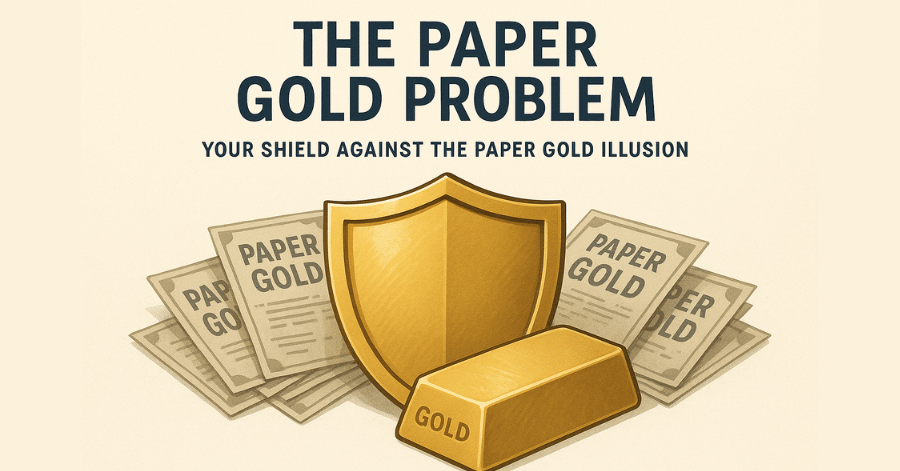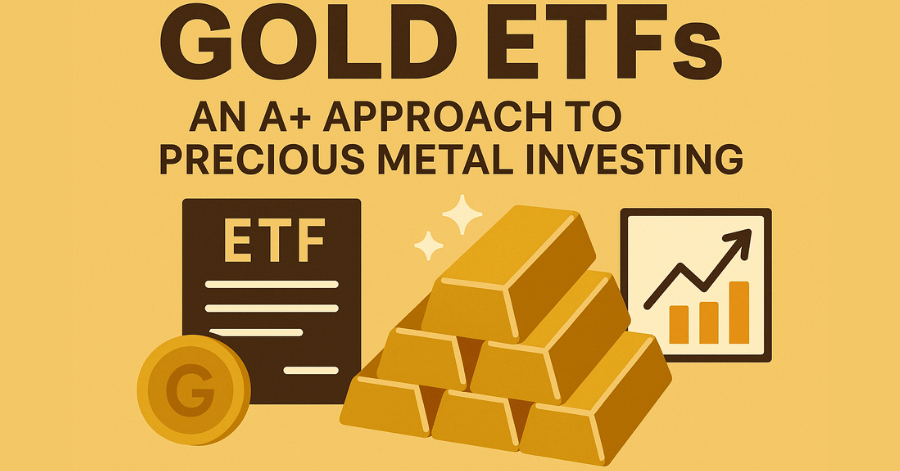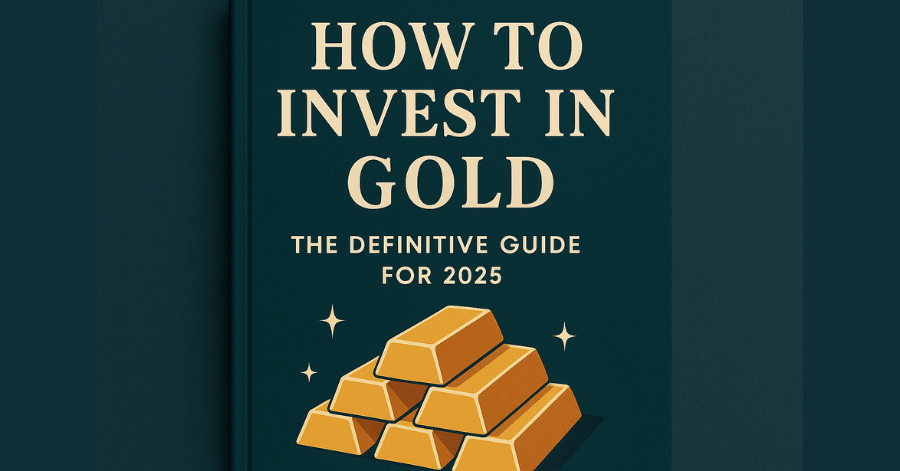Key Takeaways
- Gold ETFs offer convenient exposure to gold prices but represent indirect ownership through paper claims
- Physical gold provides direct ownership and eliminates counterparty risk entirely
- ETFs excel for short-term trading; physical gold excels for long-term wealth preservation
- Gold ETFs face higher tax rates (28% vs. standard capital gains) and systemic risks
- Only physical gold held in a Gold IRA offers true protection during financial system disruptions
Read Our Comprehensive Article About Investing In Gold
Why Gold ETFs Matter in 2025’s Uncertain Landscape
The ‘Rio Reset’ has fundamentally altered the investment landscape, driving unprecedented interest in gold as global economic uncertainties mount.
The economic upheaval following the  ‘Rio Reset’ has sparked a massive surge in gold investing, with many investors seeking the “easiest” entry point into precious metals. This search for convenience has led countless individuals toward Gold Exchange-Traded Funds (ETFs), often without fully understanding what they’re actually purchasing.
‘Rio Reset’ has sparked a massive surge in gold investing, with many investors seeking the “easiest” entry point into precious metals. This search for convenience has led countless individuals toward Gold Exchange-Traded Funds (ETFs), often without fully understanding what they’re actually purchasing.
The central question facing investors in 2025 is clear: Are Gold ETFs the right tool for securing wealth during these unprecedented times, or do they introduce hidden risks that could undermine the very protection investors seek?
This comprehensive analysis provides an authoritative examination of Gold ETFs, comparing them directly to physical gold ownership to help investors make truly informed decisions about their precious metals strategy. The stakes have never been higher, and the choice between convenience and genuine security has never been more critical.
Understanding Gold ETFs: Mechanics and Market Function
A Gold ETF (Exchange-Traded Fund) functions as a financial security that trades on major stock exchanges while tracking the price movements of gold. However, investors must understand a crucial distinction: purchasing shares in a Gold ETF provides a claim on gold, not direct ownership of the physical metal itself.
The operational mechanics involve fund managers purchasing and storing substantial quantities of physical gold bullion in secure, institutional-grade vaults managed by custodians. These custodians, typically major financial institutions, hold the gold on behalf of the fund. Investors then purchase shares representing fractional interests in this stored gold, with each share corresponding to a specific amount of the underlying metal.
The most prominent physically-backed Gold ETFs include SPDR Gold Shares (GLD) and iShares Gold Trust (IAU), which together hold hundreds of tons of gold bullion. When investors buy shares, they’re essentially purchasing a paper claim backed by this physical gold, with the ETF provider handling all storage, insurance, and security arrangements.
Gold ETFs differ significantly from mining stock ETFs or derivatives-based funds. While mining ETFs invest in gold mining companies and derivatives-based funds use financial contracts, physically-backed ETFs maintain actual gold reserves. This backing provides more direct price correlation with gold but still maintains the fundamental characteristic of indirect ownership through a financial intermediary.
The appeal lies in accessibility: investors can buy and sell Gold ETF shares through any brokerage account during market hours, providing immediate exposure to gold price movements without the complexities of physical storage, insurance, or security concerns that accompany actual gold ownership.
The Core Investment Dilemma: ETFs vs. Physical Gold
Critical Risks and Considerations for ETF Investors
Gold ETF investors face several significant risks that extend beyond normal market volatility. Understanding these risks is essential for making informed investment decisions in today’s uncertain economic environment.
Counterparty Risk: ETF investors depend entirely on multiple intermediaries functioning properly. If the fund’s custodian encounters financial difficulties, legal challenges, or operational failures, investors could face delays in accessing their investment or, in worst-case scenarios, partial or total loss. This risk multiplies during systemic crises when multiple financial institutions may face simultaneous stress.
 The “Paper Gold” Problem: During severe market disruptions, a theoretical but serious risk emerges: the possibility that paper claims on gold may exceed the actual physical gold available to back them. While major ETFs maintain regular audits, extreme market conditions could create scenarios where demand for physical delivery overwhelms available supplies, potentially leading to settlement in cash rather than gold.
The “Paper Gold” Problem: During severe market disruptions, a theoretical but serious risk emerges: the possibility that paper claims on gold may exceed the actual physical gold available to back them. While major ETFs maintain regular audits, extreme market conditions could create scenarios where demand for physical delivery overwhelms available supplies, potentially leading to settlement in cash rather than gold.
Tax Implications: The Internal Revenue Service classifies Gold ETFs as “collectibles,” subjecting long-term capital gains to a 28% tax rate—significantly higher than the 15-20% rates applied to most stocks and bonds. This tax burden can substantially erode returns over time, making ETFs less efficient for long-term wealth building compared to other investment vehicles.
Market Dependency: Gold ETFs require functioning financial markets to trade. During market closures, system outages, or extreme volatility that triggers trading halts, investors cannot access their positions. This limitation directly contradicts gold’s historical role as a crisis hedge, potentially leaving investors unable to act precisely when they most need liquidity.
Frequently Asked Questions
Can I redeem my ETF shares for actual physical gold?
No, retail investors cannot redeem ETF shares for physical gold. Only large institutional investors called “authorized participants” can exchange shares for gold bars, and only in very large quantities (typically 100,000+ shares). Individual investors can only sell their shares for cash.
Are Gold ETFs safe during economic crises?
Gold ETFs face significant risks during economic crises, including potential custodian problems, market closures, and system failures. While the underlying gold may retain value, accessing that value depends on multiple financial intermediaries functioning properly.
What are the ongoing costs of owning Gold ETFs?
Gold ETFs charge annual expense ratios ranging from 0.25% to 0.40% of your investment. These fees are automatically deducted from the fund’s performance, reducing your returns over time. Additional costs may include bid/ask spreads when trading.
How do Gold ETF taxes compare to other investments?
Gold ETFs are taxed as collectibles with a maximum long-term capital gains rate of 28%, higher than the 15-20% rates for most stocks and bonds. This makes them less tax-efficient for long-term wealth building strategies.
Can I hold Gold ETFs in my retirement account?
While you can hold Gold ETFs in traditional IRAs and 401(k)s, they are not eligible for self-directed precious metals IRAs, which offer unique tax advantages and allow direct ownership of physical gold within retirement accounts.
Strategic Conclusion: Choosing the Right Gold Investment Approach
The analysis reveals that Gold ETFs serve as excellent tools for short-term traders and those seeking convenient exposure to gold price movements. However, they fundamentally fail to address the core concerns driving the post-‘Rio Reset’ flight to gold: protection against systemic financial risks and preservation of wealth outside the traditional banking system.
For investors whose primary objective is genuine security and long-term wealth preservation, physical gold ownership offers unmatched advantages. Direct ownership eliminates counterparty risk entirely, functions independently of financial markets, and provides the tangible security that paper claims simply cannot match.
The choice between ETFs and physical gold ultimately reflects different investment philosophies: convenience versus security, paper claims versus tangible assets, market dependence versus financial independence.
Ready to secure your retirement with real ownership?

To learn more about protecting your wealth with the only form of gold that offers true ownership and eliminates counterparty risk entirely, explore a Gold IRA with Birch Gold Group.
Affiliate Disclosure: To support our mission of providing valuable financial analysis, this page may contain affiliate links. If you follow a link and make a purchase, we may earn a commission at no additional cost to you. We only recommend partners we thoroughly research and trust.









4 Comments